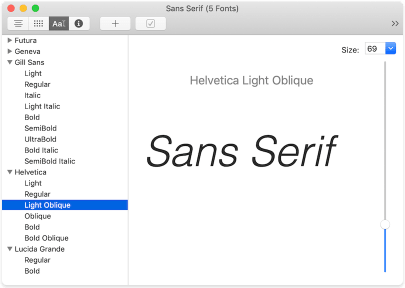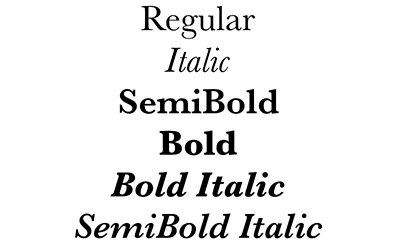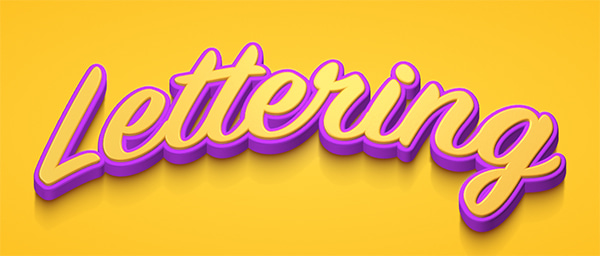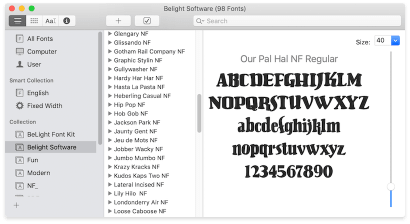Kinds of Fonts
TrueType and PostScript
The extensive use of 3D typography is clear—words that need to shout and impress the target viewer will be more dramatic and potent. Letters and signs become main characters on their own. Since such layouts don’t require a lot of space, they can be implemented anywhere and at any time. There are multiple areas in which to use 3D typography that are not as obvious, including imaginative and creative portfolios like Curriculum 3D, Scripts with Depth, product advertisements, banners, etc.
The most common types of fonts are TrueType and PostScript Type 1.
PostScript fonts were developed by Adobe Systems. Though there is actually no big difference between these types, Type 1 fonts have the reputation for being better designed. If you intend to create a high-quality design piece and are printing to a PostScript printer, you may want to consider a PostScript font.
TrueType fonts are based on a specification developed by Apple, and have gained a lot of popularity across both the Windows and Macintosh operating systems.
The main differences between TrueType and Type 1 fonts are in availability and application support. Swift Publisher and Art Text can equally handle both types of fonts.
Serif and Sans Serif
Fonts can be also classified as serif / sans serif.
A serif font is one in which some (not necessarily all) of the characters have serifs—small lines which decorate the main strokes of a letter. Studies have shown that serif fonts are generally easier to read than sans-serif fonts. The effect is most noticeable at smaller font sizes, so for body text typically a serif font is used.

A sans-serif font doesn't contain any serifs. Sans-serif fonts typically appear less formal than serif fonts, but can be used for striking effect in headlines, chapter names, and advertisements. In addition, sans-serif fonts are typically used when large print is called for, where serifs become a distraction.
Families of Typefaces
Normally fonts come in groups of a few variants. Most fonts come with a bold, italic and bold-italic variants. Some fonts may also have small caps, and semi-bold variants. A group of fonts consisting of a font and its variants is called a family of typefaces. For example, the Helvetica family consists of Helvetica, Helvetica Oblique, Helvetica Bold, Helvetica Bold Oblique.

Encoding
Encoding is the way character codes are mapped to the actual characters in a font. If you're using languages which include characters other than Latin alphabet characters (for example, Russian, Japanese, Greek), make sure the font you are using includes the appropriate encoding. The Unicode encoding, using 2 bytes per character and thus covering nearly all languages in the world, is becoming more and more widespread.
Cocoa applications correctly handle any encodings, including Unicode.
Decorative Fonts and Dingbats
Apart from regular fonts, such as those supplied with your operating system, there are lots of decorative fonts which are good for using on postcards, as headers on newsletters or letterheads.
A special group of fonts is dingbats—these fonts include various images instead of letters, and can be used as a kind of clipart collection to illustrate documents.

Using Fonts in Documents
Here is some advice on using fonts to illustrate documents.
Don't use too many different fonts in formal documents (reports, CV, overviews). It's recommended to use the one font throughout a style—such as body, headings, footnotes, etc. Of course, it's just a general recommendation—in some documents the use of various different fonts is justified from the artistic point of view.
Decorative fonts are good for letterheads. Here is a web site, offering fonts good for letterheads: LetterheadFonts.com
When designing postcards, invitations and for other informal occasions use unusual, beautiful fonts which will make your message more personalized and attractive.
Handwriting fonts are good for invitations, postcards and comments to pictures and photos.
Dingbats. The simple shapes and pictures found in dingbat fonts make them especially useful in logo design or as icons or symbols in newsletters, books, brochures, or other types of publications. You can rotate, stretch, and paint them, changing their appearance completely.
Effects, provided by Font Book. Most macOS applications use a standard system panel for managing fonts. It contains tools which help to decorate any font—for example, control underlining, strikeout characters (with a single, double or color line), change the text and background color, and control various parameters of the shadow—offset, blur, transparency and angle. All this enables you to make an ordinary font stand out.
The most often adjustable font parameter is its size. There are predefined font sizes like 14, 18, 24, 36 but you can use intermediate values. Since the mentioned above font types are vector, increasing the size doesn't affect the quality.
What if the above, ordinary methods of text editing is not illustrative enough? That’s where Art Text for Mac can help. Art Text will let you use any font in your macOS font library and visually improve it. The app offers massive range of text effects ranging from shape transformations to various texture fills, and even ability to transform regular font into 3D text.

Installing and Managing Fonts
For whatever project you’re working on, it’s important to be able to easily find, manage, and render all the fonts you need. Mac OS X offers extensive font managing capabilities.
Installing Fonts
To install fonts, you may either copy them to your Fonts folder inside your account’s Library folder, or use the Font Book utility which is located in the Applications folder. With Font Book you can install fonts without need to know the path to them, create sets of fonts, disable and enable fonts as needed, and control access to fonts by storing them in the User collection. A font disabled in Font Book will not be listed in any application, helping to manage your font lists and dialogs. It also allows you to preview fonts and your own text, so that you will always know what a word, sentence, or paragraph will look like in a particular typeface. To install a font either double-click the font you want to add or drag it into Font Book.

Fonts are stored in two libraries: system and user. If one user installed new fonts in his user library, these fonts can be unavailable for other users.
Creating Proprietary Font Collections
When there are many fonts on your computer, it’s a good idea to organize them in collections—either by specific projects or clients, or by font style or encoding (for example, Cyrillic or Japanese). It can be easily done with Font Book. To create a new collection of fonts, click the Add button (+) at the bottom of the Collection pane on the left of the Font Book window, and drag fonts there either from the Fonts pane or from a folder on the hard drive. You can easily disable and enable the entire collection or an individual font from the Edit menu.
Publishing Documents
When your document is ready, you may publish it to PDF in order to share it with others. To save a document to PDF from Swift Publisher or Art Text, choose Export from the File menu. All the fonts used in the source document will be embedded into the PDF file, so they can be viewed on any computer with Adobe Reader or Apple Preview. Furthermore, Art Text lets you export text on a transparent background, which makes it great when using text graphics in third party apps.
If you’re sending the source document (created in Swift Publisher for instance) to someone, and you’ve used some non-system fonts in it, make sure the other person has these fonts installed on their system—or the document won’t display properly.
Getting Fonts
There are lots of free and commercial fonts. Below you can find a list of Internet resources from where you can buy fonts or get them for free.
Free Fonts
The chief advantage of free fonts is in their price (that is, absence thereof). You can find lots of pretty nice free fonts—however, be prepared that their quality may be different, and you may find some of them inappropriate for your purposes. For example, many free fonts are not allowed for commercial use, so you should check the license prior to using such fonts in your projects. Many free fonts contain only limited set of characters and often do not contain full set of extended characters (including international) and symbols.
Here are some links to extensive free fonts resources:
Google Fonts Google Fonts An interactive web directory for browsing font library of 960 fonts.
Free Fonts Library An index to free font downloads.
dafont.com Lots of free and shareware fonts, including fancy, handwriting, dingbats and more.
Abstract Fonts A cool collection of more than 10,000 free fonts that really stand out.
Fonts are often supplied with other software in a bundle—so it’s an alternative way of acquiring fonts at no additional cost.
Commercial Fonts
Despite so many free fonts available, there are reasons for buying commercial fonts. Here are just a few of them:
- Commercial fonts are more carefully designed. With them you will normally get such niceties as small caps, old style figures, true ligatures, etc. The difference is especially evident in printed jobs.
- If you use free fonts—especially TrueType—you’re more likely to get into trouble at a service bureau.
- With commercial fonts you may qualify for technical support if anything goes wrong, and also can recover the fonts if you loose them due to a hard drive crash or the like. Free fonts are more difficult to track down if you happen to lose them.
- Most free fonts only include Latin character set; it’s very hard to find free fonts which include international character sets—but there are many such fonts available for purchase.
Here are some links to commercial font resources:
Fonts.com A large collection of commercial fonts available for online purchase.
monotype.com High-quality fonts for designers, developers. Custom fonts.
FontShop.com A large font warehouse.